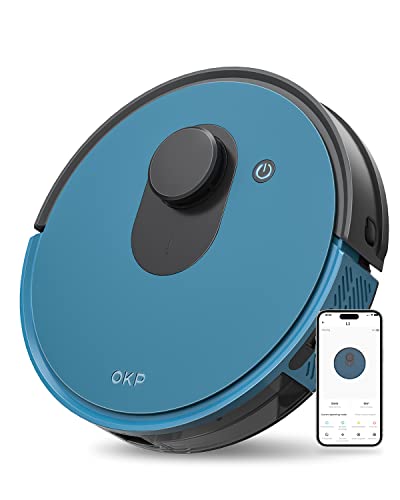Why You Should Concentrate On Improving Cleaning Robot Mop And Vacuum

How to Take Care of a Robot Mop and Vacuum
A robot vacuum and mop will save you lots of time cleaning. However, they also require regular maintenance, like emptying the dirt bins, washing the reusable cleaning pads according to the manufacturer's instructions, or eliminating single-use pads and keeping the sensors clean.
Look for mapping features to avoid making multiple passes over the same areas and app integration that lets you create schedules, modify power modes and settings and save maps of your home.
1. Empty the Dirt Bin
Regular maintenance is essential for most robot vacuums and mops. This includes emptying dirt bins and washing pads, as well as keeping track of consumables that require replacement. The better you take care of these components, the longer they will last. Some cleaning robots also require some extra attention, especially those with water tanks.

Firstly, empty the dirty dustbin completely following each cleaning session. This is an easy task, but is crucial to the performance of your robot. You should also clean your filter periodically. Refer to robots that vacuum and mop to determine the best method and when you should clean your filters.
While the mopping function of your robot may eliminate a lot of dust off your floors, there are still some small particles that may accumulate in cracks and gaps on flooring. These include skin and hair particles like dandruff, mites dirt, sand and pet hair. It is essential to use a vacuum or sweeper on occasion to clean these areas to keep these particles from causing health issues.
In addition, if you plan on using your mopping robot it is important to choose a model that comes with top-of-the-line hardware and large water and dust tanks. LEGEE for instance has one of the largest dust bins as well as water tanks in its class, which means you won't need to stop cleaning or interrupt the robotic mop to refill the tank.
Do not add vinegar or floor cleaners in the tank that holds water for your robot mop unless were instructed to do so by its manufacturer. These substances could damage the robot and invalidate its warranty.
A robot mop and vacuum is an excellent method to free up your time to concentrate on more pressing matters like your family or work. However, some stains and dirt can be too stubborn for the robot to take on. It is also important to regularly conduct a thorough cleaning yourself using a traditional vacuum cleaner in order to get rid of these tougher stains as well as clean areas that your robot isn't capable of reaching.
2. Clean the Cleaning Pads
Depending on how you use your robot mop, the pads can be stained or dirty. It is essential to clean your cleaning pads on a regular basis. You can wash them either by hand or in the washer along with your regular laundry. Avoid using fabric softeners or dryer sheets, as these can reduce the absorbency of the pad and could cause it to not work properly.
If your mop doubles as a vacuum cleaner, it will need its dust bin to be cleaned and cleaned on a regular basis. This is also true for hybrid models that sweep and vacuum with a dry mop pad. Many robot mops are also equipped with brush attachments that need to be cleaned.
You should always rinse the mop pads thoroughly to get rid of any dirt and grime. You can also soak the pads in warm water for several minutes to break loose any debris that has stuck. After they're completely clean let the pads air dry or place them in the dryer on a low heat setting. It is recommended to wash your pads every 2 to 3 months.
In the course of cleaning the mop or vacuum can often collect small particles which can cause damage to the sensors in your robot and other components. To prevent this from happening, you'll need to periodically wipe the sensors clean with a microfiber cloth. This will assist the robot navigate around the space without hitting furniture or walls.
Sensors at the base of most robot vacuums and mops are used to detect obstacles, ensuring that the machine does not get stuck in tight spaces. It is necessary to clean them often since they can become clogged up with dust and other debris.
Some robot vacuums come with self-cleaning cycles that you can run after each use. Visit the manufacturer's website to determine if the model you have comes with this feature. This process can take about two to three minutes and can be run through an app or a button on the robot. This cycle should be performed frequently with a mop or vacuum to maintain the efficiency of sensors and other components.
3. Clean the Charging Station
The majority of robot mops spray water or cleaning solution directly onto the floor to soften stains and then scrub them away with the scrubbing pad. Some robot mops utilize a disposable mop pads, whereas others can be washed and re-used. It is important to clean and empty your mop pads after cleaning sessions regardless of whether they are disposable or reusable. Follow the manufacturer's instructions. It is also important to drain and let the docking station or mop base dry between uses to avoid mildew.
Robotic mops, just like vacuum cleaners, require frequent maintenance to ensure they operate smoothly. These tasks include emptying and washing the dust bins, as well as cleaning the sensors. If your mop robot is equipped with dirt detectors, you may have to wipe it down gently every few cycles to get rid of dust. This can block the sensors, causing issues with navigation.
Many robot mops include an app that lets you to save your house's maps, set up cleaning schedules and monitor when the machine needs to be maintained. If you are looking to purchase a mop, make sure it can connect to Wi-Fi. This allows you to access the app from any place.
A top-rated model that is the Samsung Powerbot Vac + Mop is equipped with smart features that allow it to clean floors without having to be home. Its map function enables you to create virtual barriers and no-go zones for the robot, and also manually guide it to clean a specific part of the room. Its mopping and vacuuming capabilities can be used on carpeting and hard floors, making it an ideal choice for homes with both.
This 2-in-1 robot comes with an advanced object avoidance sensor, which assists it in navigating around objects such as furniture. It also has an automatic bin that can be emptying automatically, which reduces the amount that needs to be cleaned after each use. It can also be programmed to run even while you're away, which is great for busy homeowners. It's also quieter than other vacuums, which could be beneficial for those who live with noise-sensitive children or pets.
4. Clean the Sensors
Apps are available for most robot vacuums, including some vacuum and mop combos. They let you set up cleaning schedules for automatic cleaning and set cleaning modes. You can also keep track of the frequency of maintenance. The app lets you manually clean, start, stop and alter your robot's settings from anyplace in the house.
The app is particularly beneficial if the robotic cleaner has the ability to map, such as lasers, cameras, or optical dToF. This lets it save the map of the room, and navigate around furniture. These features can also help to reduce the amount of stains that appear on your floors, making your cleaning chores less labor intensive.
When your robot's mapping sensors get dirty, it may have trouble navigating throughout your home. Cleaning these sensors is important as is cleaning a smartphone screen or camera lens. The best way to do this is using a clean, dry cloth. If you use a moist or damp cloth or cleaner, you could harm the sensors and cause them to malfunction.
Also, it's an ideal idea to clean the brushes of your robot vacuum regularly. This will help avoid hair tangles and blockages of the motor. It also makes it easier for your robotic vacuum to pick up dirt. It's also a good idea to wipe down the primary roller brush since it is usually responsible for removing dirt and can build up lots of dust over time.
And lastly, make sure you only use cleaners recommended by the manufacturer of the robot. Utilizing other floor cleaners can harm the machine and void your warranty. Most brands recommend a mix of vinegar and water, or a cleaner that is specially designed for their robot. Never pour in hot water or a solution that contains abrasives because they can harm the internal components and leave an unpleasant dirt on your floors. If you have any questions refer to the owner's manual for specific instructions on how to clean your robot cleaner. This will ensure that it functions well and lasts for a longer time.
